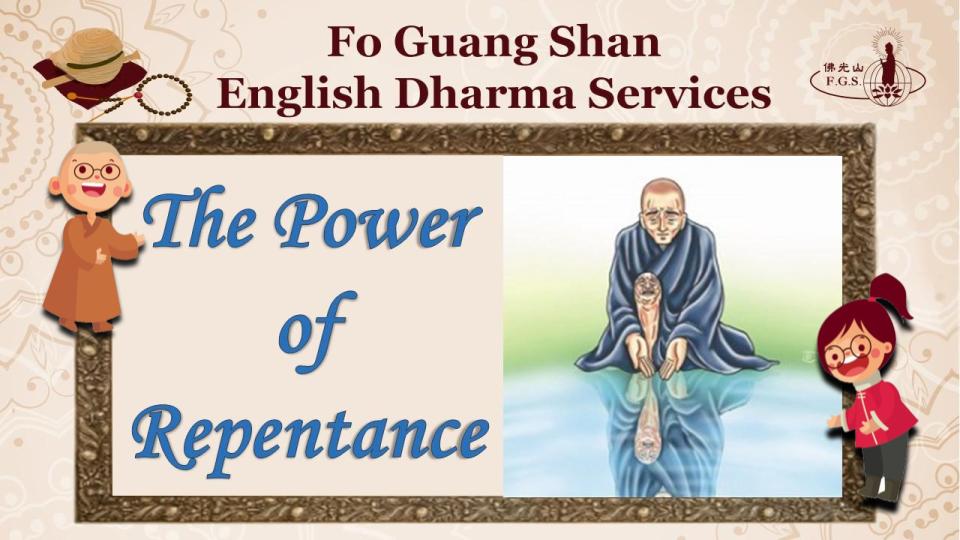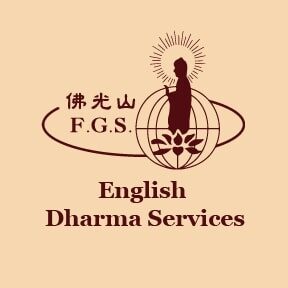
/iframe>
I. Introduction
Auspicious greetings to Dharma friends around the world! Welcome to another episode of English Dharma Services.
Ven. Zhi Tong: Hi Kathryn, good to have you joining today’s Dharma service. How do you feel?
Kathryn: Hi Venerable Zhi Tong, I am filled with joy after every Dharma service! Everyone is so diligent in their praying and chanting and this motivates me to focus better.
Ven. Zhi Tong: That’s good to know!
Kathryn: I’ve been joining temple activities for a few years now and I always wonder, why do we chant the Emperor Liang’s Repentance for the Lunar July Dharma Service?
II. Origin of the Emperor Liang’s Repentance Ceremony
Well, Kathryn, the origin of this repentance service can answer your question. Emperor Wu of Liang was considered the greatest Buddhist emperor of China. He was the founder of the Southern dynasty, and reigned during the first half of the 6th century. Emperor Wu’s first empress passed away at the young age of 30. One night, a python appeared before Emperor Wu. Unlike other pythons, this one looked the emperor straight in the eye. The emperor said, “This palace is tightly guarded; there should not be a snake here. Are you a demon trying to haunt me?”
The python answered, “I was your empress, but now reborn in the form of a python. When I was alive, I was very jealous of your concubines. I had a ferocious temper and a vicious nature. Once my anger erupted, it was like blazing fire or darting arrows, harming people and destroying things. Due to such offenses, I was reborn in a lower realm as a python. Without food and shelter, I suffer unbearable hunger and misery. Moreover, there are many parasites underneath each of my scales and they gnaw at my flesh. The pain is like sharp knives stabbing my skin. I became a python, and unlike an ordinary snake, can transform my body and come here unhindered into your royal palace, a restricted place. Mindful of your majesty’s deep affection for me in the past, I now reveal myself before you can create some merit on my behalf so that I can be rescued from this predicament.”
Emperor Wu lamented at the fate of his late empress, and the next day, he gathered a number of Buddhist monastics and explained what had happened, and asked the best method to liberate the python from its suffering. The national master, Master Baozhi, said, “The only way is to bow to the buddhas and repent sincerely on behalf of the empress.”
The Buddhist monastics then searched the sutras, gathered the names of buddhas, extracted passages, and compiled the repentance as we know it today. There are ten fascicles in total. A large repentance Dharma service was held on behalf of the late empress. One day after the Dharma service, a rare fragrance permeated the palace. No one knew where it came from, but when the emperor looked up, he saw an adorned heavenly being, who said to him, “I was the python you saw previously. Because of the merit and virtue accrued from the repentance, I was reborn in the Trayastrimsa Heaven.” After expressing gratitude, the heavenly being disappeared. The empress was freed from her suffering as a python and was reborn in the heavens through the power of repentance.
III. Significance of Repentance
Kathryn: This story reminds me of how Maudgalyayana liberates his mother from the hungry ghost realm. Through Dharma service, we redirect the merits to our ancestors in hope they will be liberated from suffering. But Maudgalyayana liberated his mother through offering to the Sangha. For Emperor Liang’s case, he liberated his empress through repentance. I remember that there are a few different Dharma services that focus on repentance.
Ven. Zhi Tong: You’re right, Kathryn. Repentance is a very important Buddhist cultivation. Besides Emperor Liang’s Repentance Ceremony, there is also the Samadhi Water Repentance, the Great Compassion Repentance, the Eighty-Eight Buddhas Great Repentance, and many more. A ritualistic form of repentance ceremony has been part of Chinese Buddhism for a very long time, it is one of the ways in which we can practice Buddhism.
Kathryn: When I hear the word “repent,” I connect it with doing something wrong. And when I read the repentance text, a lot of it talks about repenting for the things we have done before. Is this what repentance is about?
Ven. Zhi Tong: Let me ask you a question. Let’s say you did something wrong, what would you do or say?
Kathryn: Well, I always feel bad when I do something wrong. If I did something wrong to others, I’ll say sorry and apologize. Then, I try to correct my mistakes and remind myself not to repeat it in the future.
Ven. Zhi Tong: Very good! That’s what people do, this is the norm. Repentance in Buddhism shares the same idea. We often say, “to err is to human.” It is normal to make mistakes, the key is to be aware of it. As Buddhist practitioners, we learn to be mindful of our physical, verbal, and mental actions. This is how we can reflect: Is my action wholesome or unwholesome? Is it helpful or hurtful to others? When we self-reflect in this way, we feel glad when we have done something wholesome, and remorseful if we did something unwholesome. When we feel remorseful, we admit our mistake, repent, and vow to change for the better. These are the steps that we practice repentance.
Kathryn: I see. Repentance is not just about saying sorry, it is actually about being mindful of our actions. When we recite the repentance text in the Dharma service, it says that we are not just repenting for actions that we have done in this life, but in our past lives too.
IV. Origin of the Compassion Samadhi Water Repentance Ceremony
You are right. There is a verse that we often chant,
All unwholesome karmas done in the past, Stems from greed, hatred, and ignorance, Forming through physical, verbal, and mental deeds, Now, for all of them, I shall repent.
When we become observant to our physical, verbal, and mental actions, we start to realize that our unwholesome deeds stem from the Three Poisons, which are greed, hatred, and ignorance. For example, Emperor Liang’s empress was a very jealous person, and jealousy is connected to hatred. Because of her jealousy and hatred, she hurted other people. Similarly, when we inspect the intentions behind the things we do or say, we might realize that it actually stems from the Three Poisons. Hence, when we join a repentance ceremony, we are repenting for all the unwholesome deeds that we have done in the past.
The Water Samadhi Repentance is another well-known repentance ceremony. It was composed in the Tang dynasty by the Buddhist monastic Wuda. Wuda was highly respected by the royal court. He was the national master of five emperors. One day, Emperor Yizong offered a very extravagant gift to National Master Wuda, a Dharma throne made of agarwood. At the moment when Master Wuda sat on the throne, a moment of pride and arrogance arose in him and he was immediately hit by an intense pain in his knee. To his horror, a face-like tumor had appeared on his knee. This was not a normal tumor, but it has eyes, nose, and mouth like a face, and even demanded to be fed, if not Master Wuda would suffer from unbearable pain.
Master Wuda asked the facial tumor, “Who are you? What do you want from me?”
The facial tumor explained that during the Han dynasty, there were two ministers, Chao Cuo and Yuan Ang. Chao Chua suggested to the emperor to reduce the power of the seven subordinate kingdoms, but the kings were angered and plotted to rebel against the central authority. Yuan Ang, who was Chao Cuo political enemy, used this as an excuse to persuade the emperor to remove and eliminate Chao Cuo to appease the seven kings, and Chao Cuo was executed. For the next thousand years, Chao Cuo’s spirit lingered and tried to seek an opportunity to exact revenge on Yuan Ang, but had no luck as Yuan Ang was continuously reborn as a diligent practitioner. In this lifetime, Yuan Ang was reborn as the National Master Wuda. When Wuda was given the throne by the emperor, he succumbed to a moment of pride and arrogance. Chao Cuo seized this moment for his revenge and became the face-like tumor on Master Wuda’s knee.
National Master Wuda knew no medical treatment could cure the tumor on his knee. He understood that this was a karmic retribution from his past, but was at a loss with what to do. So he could only bear the pain that the tumor gave him. One day, he suddenly remembered a monk whom he nursed back to health many years ago. The monk told him that if he ever needed help, he could help him. Master Wuda traveled in search of the monk in the mountains. When he met the monk, the monk pointed to a nearby stream and said, “Wash your knee with this water, and it will eliminate your suffering.”
When Master Wuda washed his knee with the tumor, he fainted from the pain. But when he woke up, the tumor was gone. Inspired by this event, Master Wuda wrote the Compassion Samadhi Water Repentance Ceremony to advise people to repent for past unwholesome deeds and caution them from committing unwholesome deeds in the future.
When we participate in a repentance ceremony, we repent our past actions before the Buddha and redirect the merits to the people we have wronged in the past.
V. Making Vows
Kathryn: I guess this is just like how we deal with mistakes in daily life. But sometimes saying sorry is easier than making change. I find myself repeating the same mistakes again and again. What should I do then?
Then we can give rise to vows. There is a second part of the repentance verse,
Sentient beings are infinite, I vow to liberate them. Afflictions are endless, I vow to eradicate them. Teachings are immeasurable, I vow to learn them all. Buddhahood is supreme, I vow to attain it.
The first part of a repentance ceremony is about repenting for past misdeeds. After repentance, we are relieved from our burden and able to start anew in our practices. This is when we give rise to aspirations and make vows. We can vow to help and benefit others through our physical, verbal, and mental deeds. We can vow to improve our knowledge and skills. We can vow to be a kinder and more compassionate person. There are many things that we can aspire to. When we are sincere in our repentance and vow, naturally we can connect with the buddhas and bodhisattvas.
Kathryn: I see, thank you for your explanation, Venerable Zhi Tong. Repentance is a practice for us to be more aware of our actions. It motivates us to correct the unwholesome and cultivate the wholesome. I think I will have a better direction for the next few days of Dharma service!
VI. Conclusion
Ven. Zhi Tong: Wonderful, Kathryn! Thank you for coming to the temple today. Before you leave, here is a Dharma talk that you can join. The monthly “Thank Buddha It’s Friday” online English Dharma talk falls on August 26. This month’s speaker is Venerable You Ji and she will be sharing about “Doodling and Cultivation.” If you would like to join this Dharma talk, don’t forget to register online!
Kathryn: This sounds like a very interesting topic, I would love to join the Dharma talk! Thank you, Venerable Zhi Tong.
Ven. Zhi Tong: Thank you Kathryn, and thank you for joining this episode of English Dharma Service. May you find joy and inspiration in the Dharma. Omitofo.

